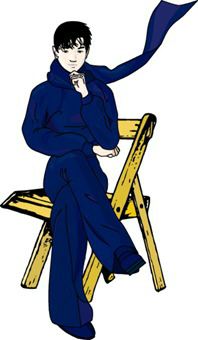
2.
SOCIETY
2-1
(1-6) Man, who
is social being, constructs society. A society is
the whole where its members gather to pursue their
own objectives by each with steady interactions. Particularly,
when members of a society share important objectives;
their interactioins can be regarded as a intentional
process for those objectives; and each member has
strong solidarity to a society, it is a society of
narrow sense, and called "community".
2-1/01
(1-9/11) Members
of a society-particularly of a community-construct
it for their existence.
2-1/02
Social phenomenon of a community is
constituted of existence wills of the consistent individuals
and their expressions and members of a society cannot
be without the society, therefore the society itself
also intends its existence.
2-1/021
Because of the characteristics of
the will of nature(1-5/1) and
the inertia of will(1-16) and
so on, an individual or some individuals can sometimes
give up their own existence for the sake of that of
their society, which is as a process for the individual's
existence.
2-1/1
(1-9/11) Every
phenomenon related to society is social phenomenon.
A social phenomenon comes to have different property
according to its members' essense and characteristics.
2-1/11
A member of a society is always a
willing body. The willing body refers to every kinds
of individual that has intentional will of any sort.
In a human phenomenon the most basic individual is
man, and if it were not a man, it must be an extended
body of man's will that includes man himself.(In this
volume I will be concerned with only human phenomenon.)
2-1/12
(1-10)
Therefore, every characteristics like intentionality,
self-causation, contradiction, and another organic
properties and so on, which appears from social phenomenon
and community phenomenon that stands on it, is that
of man.
2-1/121
Individuals in a society come to fall
in comparatively different position against shared
problems that is common to all. <1>A shared
problem that every individual meets stimulates common
aspect of every man so that it causes unidirectional(3/5-1/401)
behaviors. In this aspect a social phenomenon can
be an extended type of organic human phenomenon. <2>
On the other hand, each different position in which
each individual is stimulates each different aspect
of univeral characteristics that man possesses, and
with some addition of individual variety(1-1/32)
to that, so that it causes arbitrary behaviors-that
can thus conflict one another. A social phenomenon
of this aspect is a set of human phenomena that are
confused and nonconsistent, and sometimes conflicting.
2-1/22
A social phenomenon has both characteristics
of two aspects <1><2> always. Each of
those two aspects of a social phenomenon has different
weight depently upon situations.(From now on, a society
refers to that of narrow meaning;community, if no
particular comments.)
2-1/13
(1-1/21-6) As
a social phenomenon is a phenomenon, it includes inertia.
The inertial aspect of a social phenomenon is called
"inertial social phenomenon". The direct
root of the inertial social phenomenon is the inertial
of will(1-16) that its members
universially possess.
2-1/14
(1-9/1) Every
human phenomenon comes into being of only one, so
each social factors as its part interacts anothers
directly or indirectly.



|